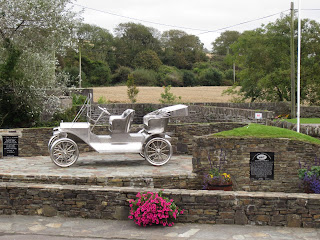We've come to the final words and pictures. But the Pilgrimage to Ireland is far from over. As Fr. Michael suggested, it now begins to work in our hearts. The images, thoughts and prayers that arise for us are the work of the Pilgrim at Home.
I almost chose "Erin Go Bragh" (Ireland forever) as the title of this last post but decided that "Ireland Rocks" (which was on Maggie's t-shirt) defines the journey even better. It was all about rocks and stones and ancient foundations, prayer stones brought and left behind, stone walls, as well as people marking time and ritual, cooking their food and building their huts and churches with what the glaciers left behind.
 Even the heather on the hill makes a statement as it creeps across the rocky outcroppings. Ireland is a place where songs keep popping up. In this case, of course, it's "The Heather on the Hill:"
Even the heather on the hill makes a statement as it creeps across the rocky outcroppings. Ireland is a place where songs keep popping up. In this case, of course, it's "The Heather on the Hill:" The mornin' dew in blinkin' yonder. There's lazy music in the rill,
And all I want to do is wander through the heather on the hill.
Okay, so that's actually about Scotland (from the 1947 Broadway hit Brigadoon by Lerner and Loewe), but it fits.
We stopped at a beach on the south coast for a time of meditation. I left one of the extra stones I had carried and scattered at various places on our journey. (It's the small crystal stone near the heart-shaped rock.) Leaving something behind is a family tradition that began 25 years ago when we were in Italy with my Uncle Bennie. He had brought soil from the family ranch near San Jose, and together we sprinkled it onto the soil of a cousins' vineyard in Tricarico, Italy. Somehow it feels as if we're making bridges from one country to the next, leaving a bit of ourselves behind (and hopefully not any alien organisms).












This sign says it all. We're standing at the tip of Ireland's most south-westerly point. Gale winds made it even more fun.
Henry Ford's father, William, was born in a small village in County Cork. This picture is for our friend Fred Deal who has one of these cars in his garage.
Holy Cross Church (our sister church perhaps?) houses a relic of the true cross (the small piece of wood in the center of the cross). We spent some time here meditating, reflecting and writing in our journals.
DUBLIN, the City of Literature.
If there are any doubts that Dublin deserves this title, then let us ask: what other city in the world names its bridges after its writers and covers its pubs with quotations from their best-known works? We went to the Writers' Museum where we saw original versions of some of the famous plays I had studied in college and, my favorite piece of furniture, James Joyce's piano.
But of course, Dublin isn't all about art and literature. Crowds of people from Kerry gathered in Dublin for the Irish Football championship game. Dublin won by one point.
The National History Museum housed a fantastic collection of treasures including the Ardagh Chalice which was found in the 19th century by a young man digging for potatoes.
Our last day included a visit to Newgrange, for many in our group a highlight of the trip. It is a megalithic passage tomb built in 3200 BCE which makes it almost 500 years older than the pyramids. Maria and friend are standing in front of the opening. Above the door is a window box which allows light to enter during the winter solstice and light the inner chamber for 17 minutes. We were lucky to be allowed inside.
We gathered together for our last night in the chapel at Emmaus Retreat House where Amber and Michael gave each of us a shell, a symbol (borrowed from Santiago de Compostela) that our pilgrimage had been completed.
Teresita and Lucia with Stephen and Rose Gordy plus many of the others that shared the time in Ireland --- Pat and Tom, Maggie and Molly, Donna, Charlie, Kim, Mary and Carol, Remy, Nancy, Karen, Mary, Amara, Pat, Kathy, Maria, Danielle, Juli, Andrea, Savarna, Billie, Patrick and Penelope, Robin. Erin go bragh!

If anyone would like to hear Martin say "get off the bus," click on this link:























